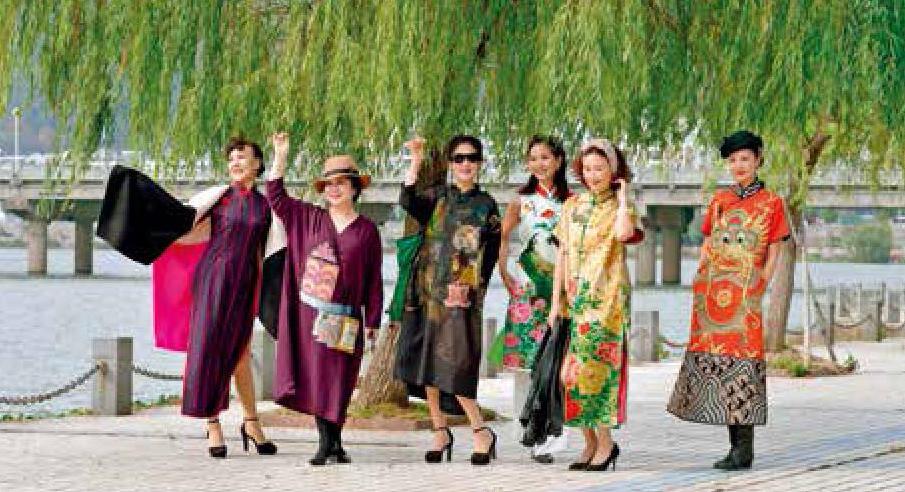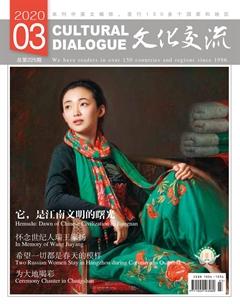一丝一线绣出传承之美
徐继宏

一针一线,一帛一裳,手绣是千年传承的中国传统文化,守护的是老祖宗的手艺和匠心。为了更好地将手绣技艺传承,王玉平先后赴苏州学苏绣,到贵州找苗绣,到广州访盘金绣,到东北寻满绣……
眼前的王玉平,一袭典雅精致的绣服,把整个人装扮得赏心悦目。
“穿上手绣的服饰,我是不是一点都不像60岁的女人,既显年轻,又赋活力?”王玉平快人快语。她说,她的梦想是能够为传承中华民族的手绣文化做点事,让手绣女红代代相传。
童年种下一个手绣梦
刺绣,俗称“绣花”,分机绣与手绣,在已加工好的织物上,以针引线,通过运针将绣线组织成各种图案和色彩的一种技艺。
“手绣是一门艺术,更是一种文化。”王玉平从小生活在浙东南沿海小城,在她的记忆中,最常做的事情就是依偎在外婆身边,帮外婆穿针搓线,看外婆捻着针的手指扬起又落下,把路边的花鸟和山涧的水流绣进丝绸锦缎中。外婆还经常带着她走街穿巷,跟深谙刺绣技巧的老绣娘学习讨教。当外婆的巧手将彩丝绣进锦缎,一幅幅精美的绣品在她眼前诞生的时候,一场关于手绣的梦在她幼小的心里扎根发芽。
传统,就是永远的时尚。王玉平说,童年时期她还有一个爱好就是跟着大人们走街串巷地看戏,特别是看到穿着戏服的演员在舞台上演出,心里很是羡慕。绣龙刺凤,花团锦簇,艳丽多彩……在王玉平的脑海里,每个绣品都是快乐的化身和温暖的代名词。
青年和中年时期的王玉平忙于家庭和事业,如今,王玉平与丈夫一起经营的企业风生水起,两个孩子也已成家立业,有了自己的事业和前程。但对于家庭幸福、事业有成的王玉平来说,手绣始终是她心中的爱、梦想和追求。
办学堂推广传统技艺
手绣技艺是中华传统文化的代表之一,如何将历史悠久的满绣、苏绣工艺与华服、旗袍的设计相结合,完美打造独具美丽和国韵的东方绣衣文化,使传统手艺与现代工艺结合,让手绣作品呈现时代芳华?王玉平一直在思考、在探寻。
2014年的一次海南行,让王玉平开始圆梦。在当地的一家“遇见手绣”服饰店,华丽的手绣服饰一下子撞开了她的心扉。“当时太激动了,多年的思考、探索和儿时的回忆一下子涌入脑海。当时,花了十几万元,把店里好看的服饰全部买了回来。回来以后,还激动了好几天。别人收藏古玩,我收藏手绣服饰。直到现在,看到这些藏品还爱不释手。”从此,在王玉平的心里多了一个结,传承手绣技艺的愿望与日俱增。
王玉平告诉笔者,在走访手绣艺人的过程中,她发现现在的手工刺绣艺术家大都已年過半百,有些传统工艺再不挖掘就可能面临失传。手绣是一项细活、慢活,需要耐得住寂寞,更需要有一份对传统文化艺术的热爱。王玉平决定创办手绣学堂,搭建绣娘生存的市场平台,让手绣这门技艺得以传承接续,让从事手绣女红技艺的艺术家有更大的生存空间。
近年来,王玉平跑了全国多个城市,结识了许多绣娘,令她更开心的是找到了扬州手绣工艺大师朱军成,遇见了杭州手绣工艺大师陈水琴,这更加坚定了她要让手绣女红代代相传的想法。
经过努力,2018年初,在家人的支持下,王玉平以苏绣和满绣的传统工艺为传承对象,组建了属于自己的绣娘团队、手绣服装设计团队及走秀表演队(爵绣十三钗),成立了杭州爵绣服装文化有限公司,专卖绣娘的绣品,还可以为客户专门定制手绣品。这既增加了绣娘的收入,又找到了手绣技艺的传播、传承载体,让手绣女红开始走进公众的视野。
把手绣推向国际舞台
一针一线,一帛一裳,手绣是千年传承的中国传统文化,守护的是老祖宗的手艺和匠心。为了更好地将手绣技艺传承,王玉平先后赴苏州学苏绣,到贵州找苗绣,到广州访盘金绣,到东北寻满绣……在她的努力下,公司里90后绣娘开始发挥主力军作用。
手工刺绣能绣出灵魂,绣出温度。在王玉平眼里,绣艺华服是彰显女人智慧、气质和优雅形体的综合体,它集手艺、审美、养心于一体。“一定要把手绣培训开展下去,让手绣走向世界,展现美丽的中国文化。”
在王玉平的脑海里,手绣要拓展市场,必须走出国门。如今,王玉平除了以“爵绣品鉴会”的模式在各大城市推广传播手绣外,还走出了国门,走向了世界舞台。她和她的团队先后赴美国、澳大利亚、德国、意大利、法国、瑞士、瑞典等国家演讲和走秀,受到了欢迎,收获了赞誉,影响力正在不断扩大。
与此同时,王玉平还想把绣服的技艺美、服饰美传递到每一个家庭。“我有一个愿望,就是要让中国传统手绣活起来、传下去,用手绣艺术美化我们的生活,温暖每一个家庭。”
Sitting down with Wang Yuping, an outspoken lady dressed stylishly, to discuss her embroidery works and dreams, was an interesting encounter to say the least.
“Do I look like a woman in my 60s? A hand-made garment like this really makes me feel young and energetic. And this is my Chinese dream that I want to share with all the others,” Wang Yuping declares.
“Embroidery is not only art but also culture.” Wang Yuping grew up surrounded by the exquisite, colorful needlework of her skilled grandma, who learned the trade from some of the master embroiders in her hometown in southeastern Zhejiang Province. Wangs favorite pastime when she was a little girl was snuggling up next to her grandma and watching her tread the needle on a piece of cloth and churn out the most beautiful patterns the little girl could ever wish to see, like there was some kind of magic behind the stitches.
Tradition is fashion. “When I was a little girl I watched village operas a lot. I was fascinated by the dazzling colors of the costumes on the village stage, and dreamt of being on the stage in costume and make-up someday,” Wang recalled. In the eye of the girl, the beautiful handmade clothes were the synonym of happiness and solace, and took her breath away.
In her adulthood years, Wang realized her childhood dream had to play second fiddle to the serious business of raising children and putting bread on the table. She spent many years working with her husband to focus on their entrepreneurial routines, but had never put her embroidery dream behind her mind, contenting herself by collecting embroidery works for enjoyment and inspiration. The new start came when she was traveling in Hainan and walked into a clothes shop.
“It was eye-opening, just like all the thoughts over the years were put together to make me realize what I really wanted to do and what I could do to make my dreams come true. I spent quite a lot in that shop and brought home as many pieces as I could.”
For Wang Yuping, embroidery is not about making money or pursuing fame, but more about keeping this exquisite craft alive and finding people to pass the relay baton on to. “It takes patience and real passion,” Wang shares. Over the years, she has been trying her best to promote the craft by working with embroiders based in other cities, including Zhu Juncheng, an outstanding embroidery master based in Yangzhou, Jiangsu Province.
Keen to put her own stamp on this fine Chinese tradition, Wang Yuping launched her own embroidery company in 2018. The Hangzhou-based company has a embroider team, a design team and a model team of 13 members.
The dreamer has visited all of Chinas “embroidery cities” where she exchanged ideas with the local artists, learned more about the craft as well as its cultural prowess, and explored collaboration possibilities. Wang has taken in a few good apprentices over the years, some born in the 1990s. “What I want to achieve is to share the enormous beauty of Chinese embroidery not only with more people in China but with the whole world.”
Wang Yuping has brought her “Juexiu” brand and products to many cities in China, and has seen her models perform on the runways of many countries including the US, Australia, Germany, Italy, France, Switzerland and Sweden, where her embroidery works in various different styles of Chinese embroidery art have garnered a growing fandom.
“Chinese embroidery is all about beauty and class. It is much more than a craft in the museum. It is something that can be shared and appreciated by all people. Chinese embroidery is a symbol of oriental elegance and grace, and can work magic in womens fashion. It makes life more beautiful, and can bring out the best of feminine charm.”
Wang Yupings ambition also includes an embroidery museum.
——以传统文化与拼布艺术课程为例

